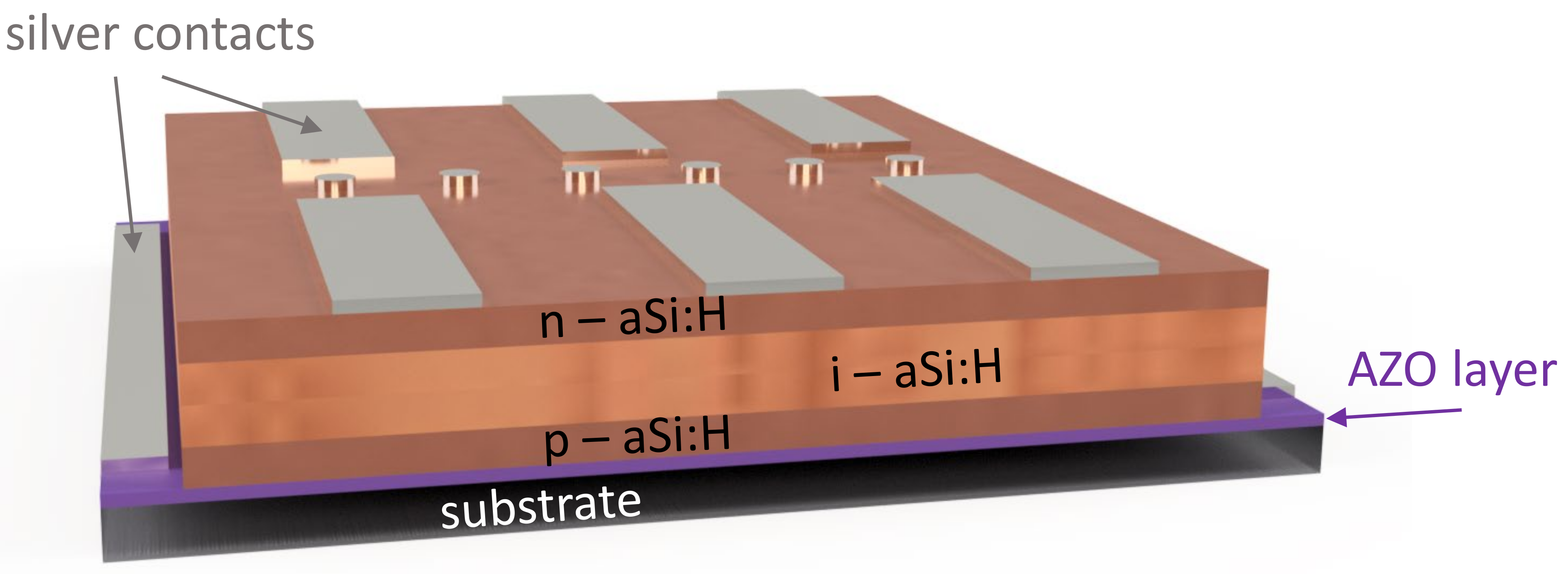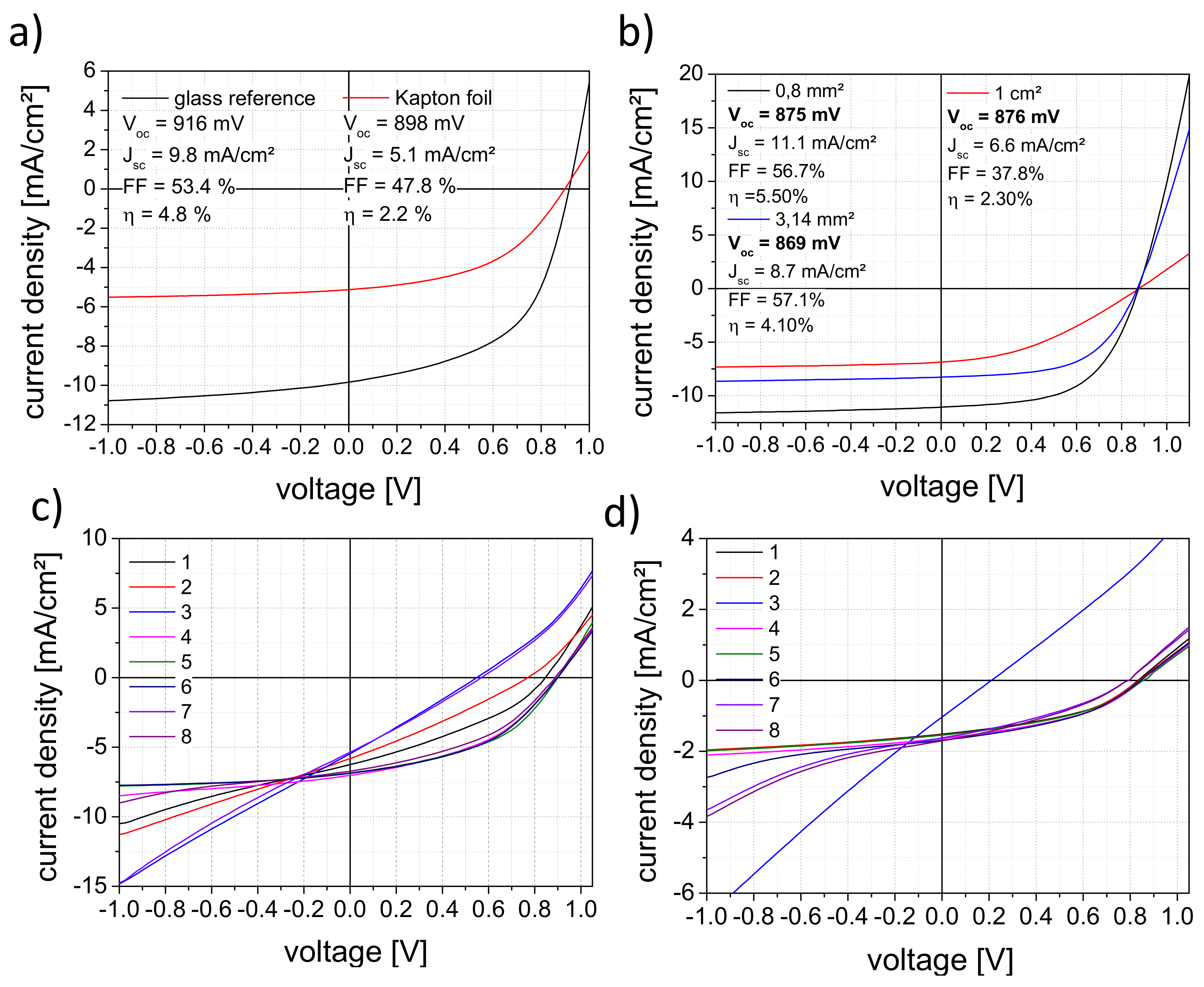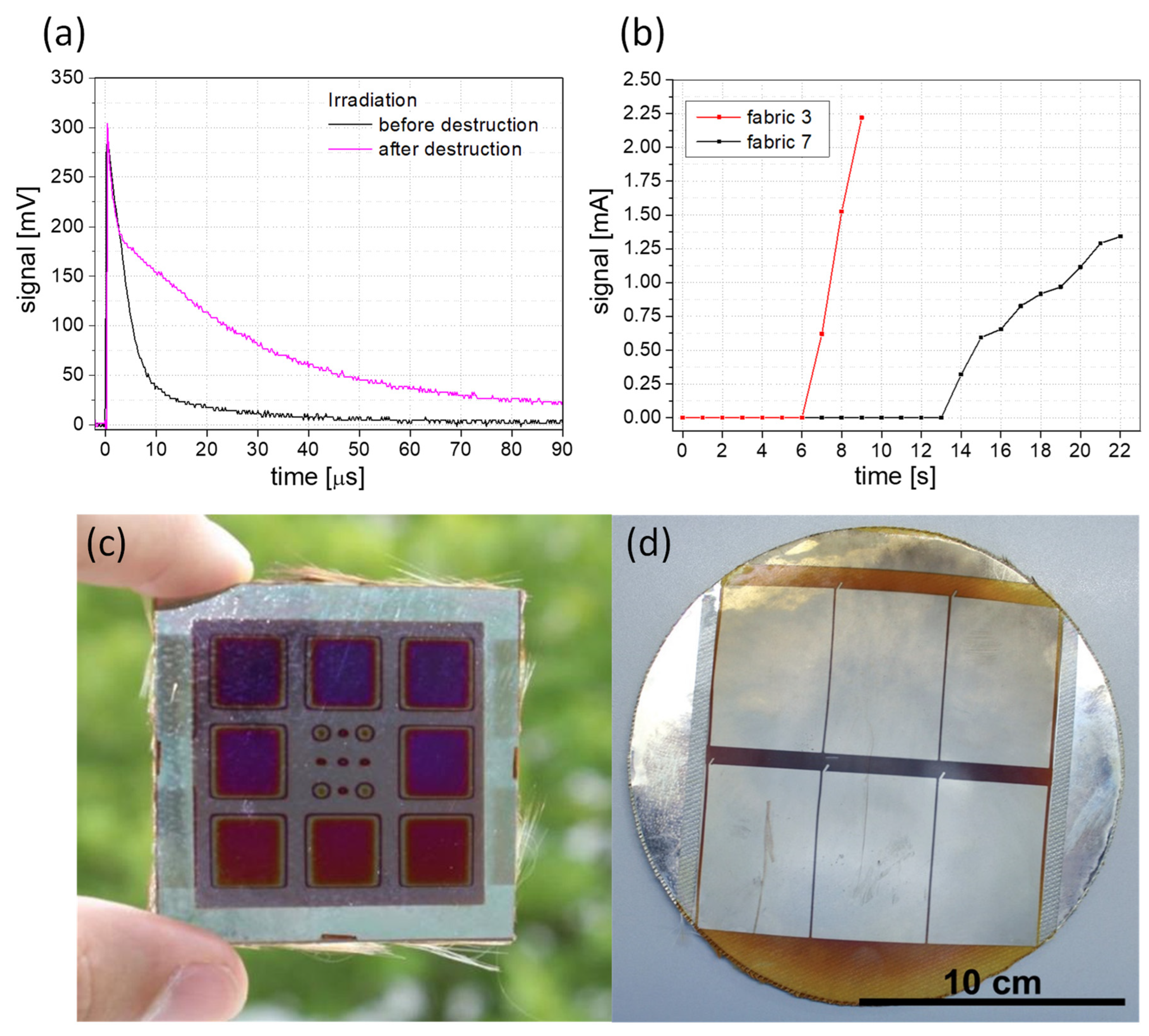Amorphous Silicon Thin-Film Solar Cells on Fabrics as Large-Scale Detectors for Textile Personal Protective Equipment in Active Laser Safety †
Abstract
1. Introduction
2. Experimental Section
3. Results and Discussions
3.1. Active Safety Concept
3.2. Laser Protection Fabric
3.3. Solar Cells
3.4. Laser Protection Compound System
3.4.1. Solar Cells on Laser Protection Fabric
3.4.2. Validation of the Compound System
4. Conclusions
Supplementary Materials
Author Contributions
Funding
Data Availability Statement
Acknowledgments
Conflicts of Interest
References
- Lugauer, F.P.; Braunreuther, S.; Wiedemann, R.; Zaeh, M.F. Laser intensity as a basis of the design of passive laser safety barriers—A dangerous approach. Phys. Procedia 2014, 56, 1384–1391. [Google Scholar] [CrossRef]
- Lugauer, F.P.; Stiehl, T.H.; Zaeh, M.F. Functional safety of hybrid laser safety systems—How can a combination between passive and active components prevent accidents? Phys. Procedia 2016, 83, 1196–1205. [Google Scholar] [CrossRef]
- Hennings, C.; Hustedt, M.; Kaiserle, S.; Wenzel, D.; Markstein, S.; Hutter, A. Passive and active protective clothing against high-power laser radiation. Phys. Procedia 2013, 41, 291–301. [Google Scholar] [CrossRef]
- Active Laser Protection Curtain ML-20. Available online: https://www.lasercomponents.com/de-en/product/active-laser-safety-textiles/ (accessed on 13 March 2023).
- Hustedt, M.; Hennings, C.; Kaierle, S.; Golebiowski, W.; Wenzel, D.; Hutter, A. Passive and active protective clothing against laser radiation. J. Laser Appl. 2013, 25, 042003. [Google Scholar] [CrossRef]
- Sreejith, S.; Ajayan, J.; Kollem, S.; Sivasankari, B. A comprehensive review of thin film amorphous silicon solar cells. Silicon 2022, 14, 8277–8293. [Google Scholar] [CrossRef]
- Plentz, J.; Andrä, G.; Pliewischkies, T.; Brückner, U.; Eisenhawer, B.; Falk, F. Amorphous silicon thin-film solar cells on glass fiber textiles. Mater. Sci. Eng B. 2016, 204, 34–37. [Google Scholar] [CrossRef]
- Hengst, C.; Menzel, S.; Rane, G.; Smirnov, V.; Wilken, K.; Leszczynska, B.; Fischer, D.; Proger, N. Mechanical Properties of ZTO, ITO, and a-Si:H multilayer films for flexible thin film solar cells. Materials 2017, 10, 245. [Google Scholar] [CrossRef]
- Elsehrawy, F.; Blomstedt, B.; Ilén, E.; Palovuori, E.; Halme, J. Optimisation of knitted fabrics a visually concealing covers for textile-integrated photovoltaics. Sol. Energy Mater. Sol. Cells 2023, 252, 112205. [Google Scholar] [CrossRef]
- Leung, S.; Gu, L.; Zhang, Q.; Tsui, K.; Shieh, J.; Shen, C.; Hsiao, T.; Hsu, C.; Li, D.; Lin, Q.; et al. Roll-to-roll fabrication of large scale and regular arrays of three-dimensional nanospikes for high efficiency and flexible photovoltaics. Sci. Rep. 2014, 4, 4243. [Google Scholar] [CrossRef]
- Graff, N.; Djurdjanovic, D. Modelling, simulation and control of roll-to-roll physical vapor deposition processes. Procedia CIRP 2022, 113, 546–551. [Google Scholar] [CrossRef]
- Meillaud, F.; Feltrin, A.; Despeisse, M.; Hauf, F.-J.; Dominé, D.; Python, M.; Döderström, T.; Cuony, P.; Boccard, M.; Nicolay, S.; et al. Realization of high efficiency micromorph tandem silicon solar cells on glass and plastic substrates: Issues and potential. Sol. Energy Mater. Sol. Cells 2011, 95, 127–130. [Google Scholar] [CrossRef]
- Söderström, T.; Hauf, F.-J.; Terrazzoni-Daudrix, V.; Ballif, C. Optimization of amorphous silicon thin film solar cells for flexible photovoltaics. J. Appl. Phys. 2008, 103, 114509. [Google Scholar] [CrossRef]
- Ramanujam, J.; Bishop, D.M.; Todorov, T.K.; Gunawan, O.; Rath, J.; Nekovei, R.; Artegiani, E.; Romeo, A. Flexible CIGS, CdTe and a-Si:H based thin film solar cells: A review. Prog. Mater. Sci. 2020, 110, 100619. [Google Scholar] [CrossRef]
- Ajmal, H.M.S.; Khan, F.; Nam, K.; Kim, H.Y.; Kim, S.D. Ultraviolet photodetction based on high-performance Co-plus-Ni doped ZnO nanorods grown by hydrothermal method on transparent plastic substrate. Nanomaterials 2020, 10, 1225. [Google Scholar] [CrossRef]
- Ajmal, H.M.S.; Khan, F.; Huda, N.U.; Lee, S.; Nam, K.; Kim, H.Y.; Eom, T.; Kim, S.D. High-performance flexible ultraviolet photodetectors with Ni/Cu-codoped ZnO nanorads grown on PET substrates. Nanomaterials 2019, 9, 1067. [Google Scholar] [CrossRef] [PubMed]
- Hakkoum, H.; Moumen, A.; Ghougali, M.; Sengouga, N.; Comini, E. The effect of structural characteristics of ZnO and NiO thin films on the performance of NiO/ZnO photodetectors. J. Mater. Sci. Mater. Electron. 2022, 33, 26604–26618. [Google Scholar] [CrossRef]
- Malčiauskiené, E.; Milašius, A.; Laureckiené, G.; Milašius, R. Influence of weave into slippage of yarn in woven fabric. Mater. Sci. 2011, 17, 47. [Google Scholar] [CrossRef]
- Stankard, S. Textiles and Fashion, 1st ed.; Sinclair, R., Ed.; Woodhead Publishing: Cambridge, UK, 2015; pp. 255–287. [Google Scholar]
- DIN EN 12254; Screens for Laser Working Places—Safety Requirements and Testing. Deutsches Institut für Normung: Berlin, Germany, 2012. Available online: https://www.din.de/de/wdc-beuth:din21:150113129 (accessed on 20 February 2023).
- IV Curve. Available online: https://www.pveducation.org/pvcdrom/solar-cell-operation/iv-curve (accessed on 4 April 2023).
- Solar-Cell Efficiecy. Available online: https://en.wikipedia.org/wiki/Solar-cell_efficiency#Fill-factor (accessed on 4 April 2023).
- Green, M.A. Solar cell fill factors: General graph and empirical expressions. Solid State Electron. 1981, 24, 787–789. [Google Scholar] [CrossRef]
- Sinton, R.A.; Cuevas, A. Contactless determination of current-voltage characteristics and minority-carrier lifetimes in semiconductors from quasi-steady-state photoconductance data. Appl. Phys. Lett. 1996, 69, 2510. [Google Scholar] [CrossRef]
- French, R.H.; Rodriquez-Parada, J.M.; Yang, M.K.; Derryberry, R.A.; Lemon, M.F.; Brown, M.J.; Haeger, C.R.; Samuels, S.L.; Romano, E.C.; Richardson, R.E. Optical properties of materials for concentrator photovoltaic systems. In Proceedings of the 34th IEEE Photovoltaic Specialists Conference, Philadelphia, PA, USA, 7–12 June 2009. [Google Scholar]
- Shi, J.; Gong, C.; Tian, X.; Yang, S.; Chu, P. Optical properties and chemical structures of Kapton-H film after proton irradiation by immersion in a hydrogen plasma. Appl. Surf. Sci. 2012, 258, 3829–3834. [Google Scholar] [CrossRef]
- Ibrahim, A. Effect of shadow and dust on the performance of silicon solar cell. J. Basic Appl. Sci. Res. 2011, 1, 222–230. [Google Scholar]
- Fabre, E.; Mautref, M.; Mircea, A. Trap saturation in silicon solar cells. Appl. Phys. Lett. 1975, 27, 239. [Google Scholar] [CrossRef]
- Merten, J.; Aseni, J.M.; Voz, C.; Dhah, A.V.; Plartz, R.; Andreu, R. Improved Equivalent Circuit and analytical model for amorphous silicon solar cells and modules. IEEE Trans. Electron. Devices 1998, 45, 423–429. [Google Scholar] [CrossRef]
- Glunz, S.W.; Nekarda, J.; Mäckel, H.; Cuevas, A. Analyzing back contact of silicon solar cells by Suns-Voc-measurements at high illumination densities. In Proceedings of the 22nd European Photovoltaic Solar Energy Conference and Exhibition, Milan, Italy, 3–7 September 2007. [Google Scholar]
- Pallarès, J.; Cabré, R.; Marsal, L.F. A compact equivalent circuit for the dark current-voltage characteristics of nonideal solar cells. J. Appl. Phys. 2006, 100, 084513. [Google Scholar] [CrossRef]
- Galiana, B.; Algora, C.; Rey-Stolle, I. Explanation for the dark I-V curve of III-V concentrator solar cells. Prog. Photovolt. Res. Appl. 2008, 16, 331–338. [Google Scholar] [CrossRef]
- Schott-Borofloat-Technical-Data-Sheet-English-26032019. Available online: https://www.schott.com/de-de/products/borofloat-p1000314/downloads (accessed on 3 March 2023).
- Wilson, J.I.B.; Mather, R.E. Photovoltaic solar textiles. Proceedings 2019, 32, 4. [Google Scholar]
- Hupfer, M.L.; Gawlik, A.; Dellith, D.; Plentz, J. Aluminum-doped zinc oxide improved by silver nanowires for flexible, semitransparent and conductive electrodes on textile with high temperature stability. Materials 2023, 16, 3961. [Google Scholar] [CrossRef]
- Kamioka, T.; Hayashi, Y.; Nakamura, K.; Ohshita, Y. Efficiency improvement by charged-insulator layers for IBC-SHJ. Energy Procedia 2016, 92, 96–102. [Google Scholar] [CrossRef]
- Gawlik, A.; Höger, I.; Bergmann, J.; Plentz, J.; Schmidt, T.; Falk, F.; Andrä, G. Optimized emitter contacting on multicrystalline silicon thin film solar cells. Phys. Status Solidi RRL 2015, 9, 397–400. [Google Scholar] [CrossRef]
- Meena, J.S.; Choi, S.B.; Jung, S.; Kim, J. Electronic textiles: New age of wearable technology for healthcare and fitness solution. Mater. Today Bio 2023, 19, 100565. [Google Scholar] [CrossRef]









Disclaimer/Publisher’s Note: The statements, opinions and data contained in all publications are solely those of the individual author(s) and contributor(s) and not of MDPI and/or the editor(s). MDPI and/or the editor(s) disclaim responsibility for any injury to people or property resulting from any ideas, methods, instructions or products referred to in the content. |
© 2023 by the authors. Licensee MDPI, Basel, Switzerland. This article is an open access article distributed under the terms and conditions of the Creative Commons Attribution (CC BY) license (https://creativecommons.org/licenses/by/4.0/).
Share and Cite
Gawlik, A.; Brückner, U.; Schmidl, G.; Wagner, V.; Paa, W.; Plentz, J. Amorphous Silicon Thin-Film Solar Cells on Fabrics as Large-Scale Detectors for Textile Personal Protective Equipment in Active Laser Safety. Materials 2023, 16, 4841. https://doi.org/10.3390/ma16134841
Gawlik A, Brückner U, Schmidl G, Wagner V, Paa W, Plentz J. Amorphous Silicon Thin-Film Solar Cells on Fabrics as Large-Scale Detectors for Textile Personal Protective Equipment in Active Laser Safety. Materials. 2023; 16(13):4841. https://doi.org/10.3390/ma16134841
Chicago/Turabian StyleGawlik, Annett, Uwe Brückner, Gabriele Schmidl, Volker Wagner, Wolfgang Paa, and Jonathan Plentz. 2023. "Amorphous Silicon Thin-Film Solar Cells on Fabrics as Large-Scale Detectors for Textile Personal Protective Equipment in Active Laser Safety" Materials 16, no. 13: 4841. https://doi.org/10.3390/ma16134841
APA StyleGawlik, A., Brückner, U., Schmidl, G., Wagner, V., Paa, W., & Plentz, J. (2023). Amorphous Silicon Thin-Film Solar Cells on Fabrics as Large-Scale Detectors for Textile Personal Protective Equipment in Active Laser Safety. Materials, 16(13), 4841. https://doi.org/10.3390/ma16134841






